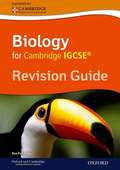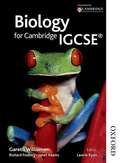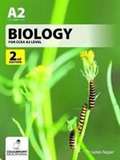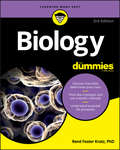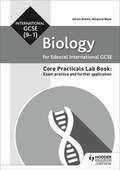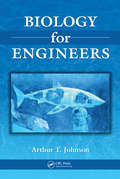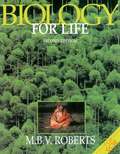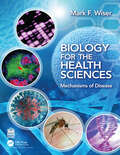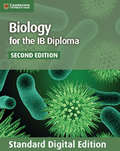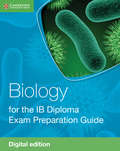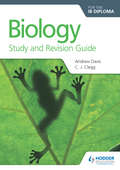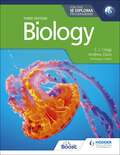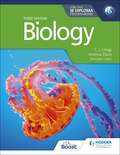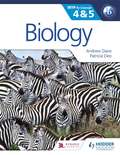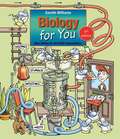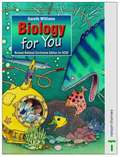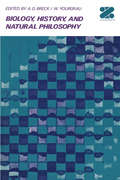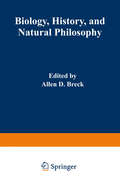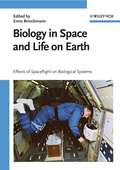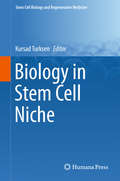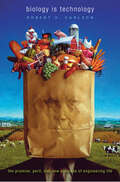- Table View
- List View
Biology Exam Practice for CCEA AS Level
by Dr James NapierWorkbook containing practice questions of examination standard for the current CCEA AS Biology specification. Ideal for revision or to reinforce knowledge. Full answers and mark scheme available online via this link: http://colourpointeducational.com/media/content/ASBiologyExamPracticeMarkScheme.pdf All questions were specially commissioned for this book and are not from past papers. The workbook also contains an introductory section with tips and advice on examination technique. The author, Dr James Napier, is a well-known Biology author who, prior to his recent retirement, was vice-principal in a Northern Ireland grammar school.
Biology for Cambridge iGCSE: Revision Guide (PDF)
by Ron PickeringThe Oxford Revision Guides series builds on the fact that pictures are easier to memorise than words. Each topic is summarised on a single page using annotated diagrams and concise notes with a full index for easy reference. Students will save valuable revision time by using these notesinstead of condensing their own. In fact, many students are choosing to buy their own copies so they can colour code or highlight them as they might do their own revision notes.
Biology for Cambridge IGCSE (International Secondary) (PDF)
by Janet Adams Gareth Williams Lawrie Ryan Richard FosberyBiology for Cambridge IGCSE is endorsed by Cambridge International Examinations and matches specification 0610. It is written by a team of experienced authors and examiners and is ideal for international school students. Features include an exam focus with exam-style questions, activities, case studies, key points amp; 'Did you know?' sections.
Biology for CCEA A2 Level (PDF)
by James NapierThis popular resource has been comprehensively updated to cover the revised CCEA A2 level Biology specification. Following the same content as the specification, the book is presented in full colour with over two hundred illustrations. This bright and clear layout will aid students’ understanding of the course. Sample examination questions are also provided throughout to reinforce learning and aid preparation for the exam. New material addressing the practical work in the A2 3 paper has been added to this edition. Contents A2 1 Physiology, Co-ordination and Control, and Ecosystems Chapter 1 – Homeostasis and the Kidney Chapter 2 – Immunity Chapter 3 – Coordination and Control in Plants Chapter 4 – Neurones and Synapses Chapter 5 – The Eye and Muscle Chapter 6 – Populations and Communities Chapter 7 – Ecological Energetics and Nutrient Cycling A2 2 Biochemistry, Genetics and Evolutionary Trends Chapter 8 – Respiration Chapter 9 – Photosynthesis Chapter 10 – DNA as the Genetic Code (Protein Synthesis) Chapter 11 – Gene Technology Chapter 12 – Genes and Patterns of Inheritance Chapter 13 – Population Genetics Chapter 14 – The Plant and Animal Kingdoms Chapter 15 – Statistics The author, Dr James Napier, is a well-known Biology author and a former teacher in a Northern Ireland Grammar School.
Biology For Dummies
by Rene Fester KratzThe ultimate guide to understanding biology Have you ever wondered how the food you eat becomes the energy your body needs to keep going? The theory of evolution says that humans and chimps descended from a common ancestor, but does it tell us how and why? We humans are insatiably curious creatures who can't help wondering how things work—starting with our own bodies. Wouldn't it be great to have a single source of quick answers to all our questions about how living things work? Now there is. From molecules to animals, cells to ecosystems, Biology For Dummies answers all your questions about how living things work. Written in plain English and packed with dozens of enlightening illustrations, this reference guide covers the most recent developments and discoveries in evolutionary, reproductive, and ecological biology. It's also complemented with lots of practical, up-to-date examples to bring the information to life. Discover how living things work Think like a biologist and use scientific methods Understand lifecycle processes Whether you're enrolled in a biology class or just want to know more about this fascinating and ever-evolving field of study, Biology For Dummies will help you unlock the mysteries of how life works.
Biology For Dummies
by Rene Fester KratzThe ultimate guide to understanding biology Have you ever wondered how the food you eat becomes the energy your body needs to keep going? The theory of evolution says that humans and chimps descended from a common ancestor, but does it tell us how and why? We humans are insatiably curious creatures who can't help wondering how things work—starting with our own bodies. Wouldn't it be great to have a single source of quick answers to all our questions about how living things work? Now there is. From molecules to animals, cells to ecosystems, Biology For Dummies answers all your questions about how living things work. Written in plain English and packed with dozens of enlightening illustrations, this reference guide covers the most recent developments and discoveries in evolutionary, reproductive, and ecological biology. It's also complemented with lots of practical, up-to-date examples to bring the information to life. Discover how living things work Think like a biologist and use scientific methods Understand lifecycle processes Whether you're enrolled in a biology class or just want to know more about this fascinating and ever-evolving field of study, Biology For Dummies will help you unlock the mysteries of how life works.
Biology For Edexcel International GCSE: Core Practicals Lab Book - Exam Practice and Further Application
by Adrian Schmit Margaret RoyalProvide full coverage of the required practicals and build students' working scientifically skills with questions that enable them to apply their knowledge to new contexts. - Extend knowledge and build working scientifically skills with 'Further Application' sections that provide additional questions to allow students to practice applying their knowledge. - Help guide students through the practical, the analysis of results, and generating a reasoned conclusion with scaffolded questions. - Get exam ready with exam-style questions, guidance on how practicals are assessed, a list of useful equations, and a checklist to monitor progress. - Cover all the required practicals with methods provided, complete with safety notes and guidance on equipment.
Biology for Engineers
by Arthur T. JohnsonBiology is a critical application area for engineering analysis and design, and students in engineering programs must be well-versed in the fundamentals of biology as they relate to their field. Biology for Engineers is an introductory text that minimizes unnecessary memorization of connections and classifications and instead emphasizes concepts, t
Biology for Life (2nd edition)
by Roberts, Michael Bliss VaughnBiology for Life is the leading text for 14-16 year olds in Caribbean schools. This flexible, attractive text is clear and easy to read, providing material for a wide range of abilities. Biology for life contains practical investigations which give clear instructions, and allow students to work independently of the teacher.
Biology for Life (2nd edition) (PDF)
by Roberts Michael Bliss VaughnBiology for Life is the leading text for 14-16 year olds in Caribbean schools. This flexible, attractive text is clear and easy to read, providing material for a wide range of abilities. Biology for life contains practical investigations which give clear instructions, and allow students to work independently of the teacher.
Biology for the Health Sciences: Mechanisms of Disease
by Mark F WiserBiology is central to our understanding of health and disease and to the development of effective treatments, and thus it is critical that health professionals have a solid grounding and knowledge comfort in the pathogenesis and mechanisms of disease processes. This innovative new textbook draws these topics together, providing an accessible introduction across four central disciplines - basic biology, biotechnology, non-infectious disease and infectious disease. Key Features: Provides students of biology and those going into health care professions with a strong foundation to understand the pathogenesis of disease at the molecular and cellular level Focuses on the etiology and pathophysiology of the major human diseases by body system, including diabetes and nutritional disorders, cardiovascular disease, neurodegenerative diseases, and cancer, aligned to medicine and health science course structure Covers mechanisms of infectious disease transmission, as well as disease pathophysiology, and considers the impact of antibiotic resistance Reviews the applications of biotechnology and genomics to human health in diagnosis and treatment, as well as to our understanding of disease and disease surveillance Each chapter contains a mini glossary of key terms and associated definitions, and review questions allow students to assess how much of the chapter they have understood Digital resources accompany the textbook, such as interactive quizzes for students to engage with and figure slides of the book's illustrations that instructors can use in lectures Enhanced throughout with plentiful illustrations, Biology for the Health Sciences is an essential companion for any student of the health sciences and for biological science students studying the causes of disease as part of a wider course.
Biology for the Health Sciences: Mechanisms of Disease
by Mark F WiserBiology is central to our understanding of health and disease and to the development of effective treatments, and thus it is critical that health professionals have a solid grounding and knowledge comfort in the pathogenesis and mechanisms of disease processes. This innovative new textbook draws these topics together, providing an accessible introduction across four central disciplines - basic biology, biotechnology, non-infectious disease and infectious disease. Key Features: Provides students of biology and those going into health care professions with a strong foundation to understand the pathogenesis of disease at the molecular and cellular level Focuses on the etiology and pathophysiology of the major human diseases by body system, including diabetes and nutritional disorders, cardiovascular disease, neurodegenerative diseases, and cancer, aligned to medicine and health science course structure Covers mechanisms of infectious disease transmission, as well as disease pathophysiology, and considers the impact of antibiotic resistance Reviews the applications of biotechnology and genomics to human health in diagnosis and treatment, as well as to our understanding of disease and disease surveillance Each chapter contains a mini glossary of key terms and associated definitions, and review questions allow students to assess how much of the chapter they have understood Digital resources accompany the textbook, such as interactive quizzes for students to engage with and figure slides of the book's illustrations that instructors can use in lectures Enhanced throughout with plentiful illustrations, Biology for the Health Sciences is an essential companion for any student of the health sciences and for biological science students studying the causes of disease as part of a wider course.
Biology for the IB Diploma (IB Diploma)
by Brenda WalpoleBiology for the IB Diploma, Second edition covers in full the requirements of the IB syllabus for Biology for first examination in 2016. The second edition of this well-received Coursebook is fullly updated for the IB Biology syllabus for first examination in 2016, comprehensively covering all requirements. Get the best coverage of the syllabus with clear assessment statements, and links to Theory of Knowledge, International-mindedness and Nature of Science themes. Exam preparation is supported with plenty of sample exam questions, online test questions and exam tips. Chapters covering the Options and Nature of Science, assessment guidance and answers to questions are included in the free online material available with the book.
Biology for the IB Diploma Exam Preparation Guide Digital Edition (IB Diploma)
by Brenda WalpoleThis Exam Preparation Guide offers support for students as they prepare for their IB Diploma Biology exams. Containing up-to-date material that matches the new 2016 IB diploma syllabus and packed full of guidance specifically designed to help students apply their knowledge in exams such as Model Answers, Annotated Exemplar Answers, Worked Examples and hints throughout to help students hone their revision and exam technique and avoid common mistakes. Written in an engaging and student friendly tone, this Exam Preparation Guide is perfect for international learners.
Biology for the IB Diploma Study and Revision Guide
by Andrew Davis C. J. CleggStretch your students to achieve their best grade with these year round course companions; providing clear and concise explanations of all syllabus requirements and topics, and practice questions to support and strengthen learning. - Consolidate revision and support learning with a range of exam practice questions and concise and accessible revision notes- Practise exam technique with tips and trusted guidance from examiners on how to tackle questions- Focus revision with key terms and definitions listed for each topic/sub topic
Biology for the IB Diploma Third edition
by C. J. Clegg Andrew DavisDeveloped in cooperation with the International Baccalaureate®Trust experienced and best-selling authors to navigate the new syllabuses confidently with these coursebooks that implement inquiry-based and conceptually-focused teaching and learning.- Ensure a continuum approach to concept-based learning through active student inquiry; our authors are not only IB Diploma experienced teachers but are also experienced in teaching the IB MYP and have collaborated on our popular MYP by Concept series. - Build the skills and techniques covered in the Tools (Experimental techniques, Technology and Mathematics) with direct links to the relevant parts of the syllabus; these skills also provide the foundation for practical work and internal assessment.- Integrate Theory of Knowledge into your lessons with TOK boxes and Inquiries that provide real-world examples, case studies and questions. The TOK links are written by the author of our bestselling TOK coursebook, John Sprague and Paul Morris, our MYP by Concept series and Physics co-author.- Develop approaches to learning with ATL skills identified and developed with a range of engaging activities with real-world applications. - Explore ethical debates and how scientists work in the 21st century with Nature of Science boxes throughout. - Help build international mindedness by exploring how the exchange of information and ideas across national boundaries has been essential to the progress of science and illustrates the international aspects of science. - Consolidate skills and improve exam performance with short and simple knowledge-checking questions, exam-style questions, and hints to help avoid common mistakes.
Biology for the IB Diploma Third edition
by C. J. Clegg Andrew DavisDeveloped in cooperation with the International Baccalaureate®Trust experienced and best-selling authors to navigate the new syllabuses confidently with these coursebooks that implement inquiry-based and conceptually-focused teaching and learning.- Ensure a continuum approach to concept-based learning through active student inquiry; our authors are not only IB Diploma experienced teachers but are also experienced in teaching the IB MYP and have collaborated on our popular MYP by Concept series. - Build the skills and techniques covered in the Tools (Experimental techniques, Technology and Mathematics) with direct links to the relevant parts of the syllabus; these skills also provide the foundation for practical work and internal assessment.- Integrate Theory of Knowledge into your lessons with TOK boxes and Inquiries that provide real-world examples, case studies and questions. The TOK links are written by the author of our bestselling TOK coursebook, John Sprague and Paul Morris, our MYP by Concept series and Physics co-author.- Develop approaches to learning with ATL skills identified and developed with a range of engaging activities with real-world applications. - Explore ethical debates and how scientists work in the 21st century with Nature of Science boxes throughout. - Help build international mindedness by exploring how the exchange of information and ideas across national boundaries has been essential to the progress of science and illustrates the international aspects of science. - Consolidate skills and improve exam performance with short and simple knowledge-checking questions, exam-style questions, and hints to help avoid common mistakes.
Biology for the IB MYP 4 & 5: By Concept (PDF)
by Andrew DavisEndorsed by the IB Drive meaningful inquiry through a unique concept-driven narrative. - Supports every aspect of assessment with opportunities that use the criteria - Gives you easy ways to differentiate and extend learning - Provides a meaningful approach by integrating the inquiry statement in a global context - Develops critical-thinking skills with activities and summative sections rooted in the ATL framework This title is also available in two digital formats via Dynamic Learning. Find out more by clicking on the links at the top of the page.
Biology for You: Fifth Edition For All Gcse Examinations
by Gareth WilliamsCovering all GCSE specifications, this tried and tested series has been fully updated to match the (9-1) GCSE Biology specifications for first examination in 2018, as well as international specifications. With a focus on science, concepts develop naturally, engaging students and enabling them to get a thorough understanding of Biology.
Biology for You (Revised National Curriculum Edition for GCSE): Textbook (PDF)
by Gareth Williams Nick PaulThe most popular textbook for GCSE Co-ordinated Science syllabuses. Using a highly motivational and accessible style of material presentation, the book is written to encourage a wide range of students to achieve success at GCSE. Single and Double Science can be taught separately, with options being clearly marked.
Biology, History, and Natural Philosophy
by Allen D. Breck and Wolfgang YourgrauIn a world that peers over the brink of disaster more often than not it is difficult to find specific assignments for the scholarly community. One speaks of peace and brotherhood only to realize that for many the only real hope of making a contribution may seem to be in a field of scientific specialization seemingly irrelevant to social causes and problems. Yet the history of man since the beginnings of science in the days of the Greeks does not support this gloomy thesis. Time and again we have seen science precipitate social trends or changes in the humanistic beliefs that have a significant effect on the scientific community. Not infrequently the theoretical scientist, triggered by society's changing goals and understandings, finds ultimate satisfaction in the work of his colleagues in engineering and the other applied fields. Thus the major debate in mid-nineteenth century in which the evidence of natural history and geology at variance with the Biblical feats provided not only courage to a timid Darwin but the kind of audience that was needed to fit his theories into the broad public dialogue on these topics. The impact of "Darwinism" was felt far beyond the scientific community. It affected social thought, upset religious certainties and greatly affected the teaching of science.
Biology, History, and Natural Philosophy: Based on the Second International Colloquium held at the University of Denver
by Allen D. Breck and Wolfgang YourgrauIn a world that peers over the brink of disaster more often than not it is difficul t to find specific assignments for the scholarly community. One speaks of peace and brotherhood only to realize that for many the only real hope of making a contribution may seem to be in a field of scientific specialization seemingly irrelevant to social causes and problems. Yet the history of man since the beginnings of science in the days of the Greeks does not support this gloomy thesis. Time and again we have seen science precipitate social trends or changes in the humanistic beliefs that have a significant effect on. the scientific community. Not infrequently the theoretical scientist, triggered by society's changing goals and understandings, finds ultimate satisfaction in the work of his colleagues in engineering and the other applied fields. Thus the major debate in mid-nineteenth century in which the evidence of natural history and geology at variance with the Biblical feats provided not only courage to a timid Darwin but the kind of audience that was needed to fit his theories into the broad public dialogue on these topics. The impact of "Darwinism" was felt far beyond the scientific community. It affected social thought, upset religious certainties and greatly affected the teaching of science.
Biology in Space and Life on Earth: Effects of Spaceflight on Biological Systems
by Enno BrinckmannThis concise yet comprehensive treatment of the effects of spaceflight on biological systems includes issues at the forefront of life sciences research, such as gravitational biology, immune system response, bone cell formation and the effects of radiation on biosystems. Edited by a leading specialist at the European Space Agency (ESA) with contributions by internationally renowned experts, the chapters are based on the latest space laboratory experiments, including those on SPACELAB, ISS, parabolic flights and unmanned research satellites. An indispensable source for biologists, medical researchers and astronautics experts alike. The results of Space flight experiments, ground controls and flight simulations pave the way for a better understanding of gravity reactions in various organisms down to molecular mechanisms. This publication marks also the beginning of a new Space flight era with the construction and exploitation of the International Space Station (ISS) which provides a platform for an in-depth continuation of experiments under weightlessness in Low Earth Orbit and beyond.
Biology in Stem Cell Niche: Methods And Protocols (Stem Cell Biology and Regenerative Medicine #1035)
by Kursad TurksenThis comprehensive volume explores functions, pathologies, and applications of stem cells in relation to the niches in which they develop. Ten chapters cover the subject in depth, from a historical perspective through signaling, hormonal control, quiescence, biomimetics, epigenetics, engineering strategies for emulating, tumorigenesis and more. The chapter authors represent a broad range of international expertise and perspectives.This installment of the popular Stem Cell Biology and Regenerative Medicine series delivers authoritative, international perspectives on this rapidly growing field. Biology of Stem Cell Niche is an ideal complementary volume to Tissue-Specific Stem Cell Niche and Adult Stem Cells, Second Edition and will be invaluable to clinicians and researchers working with stem cells as well as to postgraduate trainees who are studying them.
Biology Is Technology: The Promise, Peril, and New Business of Engineering Life
by Robert H. CarlsonTechnology is a process and a body of knowledge as much as a collection of artifacts. Biology is no different—and we are just beginning to comprehend the challenges inherent in the next stage of biology as a human technology. It is this critical moment, with its wide-ranging implications, that Robert Carlson considers in Biology Is Technology. He offers a uniquely informed perspective on the endeavors that contribute to current progress in this area—the science of biological systems and the technology used to manipulate them. In a number of case studies, Carlson demonstrates that the development of new mathematical, computational, and laboratory tools will facilitate the engineering of biological artifacts—up to and including organisms and ecosystems. Exploring how this will happen, with reference to past technological advances, he explains how objects are constructed virtually, tested using sophisticated mathematical models, and finally constructed in the real world. Such rapid increases in the power, availability, and application of biotechnology raise obvious questions about who gets to use it, and to what end. Carlson’s thoughtful analysis offers rare insight into our choices about how to develop biological technologies and how these choices will determine the pace and effectiveness of innovation as a public good.

